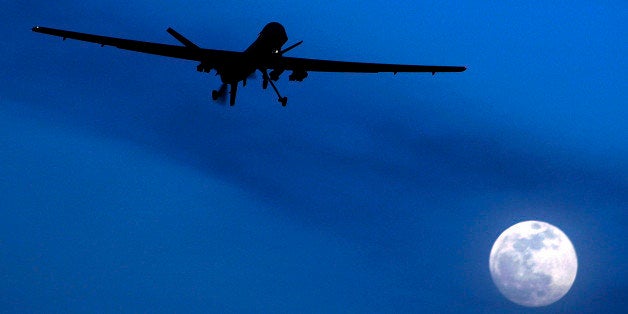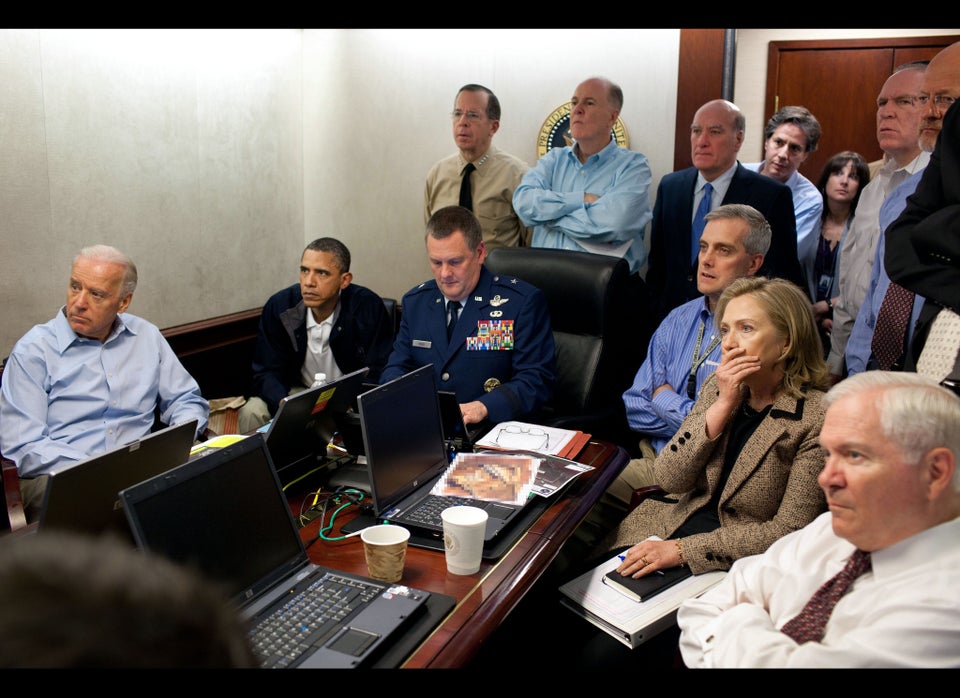
WASHINGTON -- In a May 2013 speech at the National Defense University, President Barack Obama offered a rare glimpse into upcoming changes to one of the U.S.’s most closely held covert operations: the ongoing drone strike campaign in the Middle East. Cryptically, he suggested, the White House would start moving to transfer control of the nation’s targeted killing program from the CIA to the Department of Defense.
Obama's discreet reference underscored earlier news reports of a draft presidential directive that would initiate this change. But despite the flurry of chatter that followed the president's speech, U.S. officials cautioned that the process of transferring the operationally clunky drone program to the Pentagon “was not something that would happen overnight.”
The thinking behind the shift made enough sense. The CIA was never intended to deal lethal blows -- its charter is primarily as an intelligence collector, not a paramilitary organization. Transparency-wise, the move would bring the controversial drone program out of the shadows, since targeted killings are covert operations when carried out by the CIA. And it could help the Obama administration improve public perceptions of its military offensives: After all, it's much easier to tout a successful drone strike when you're allowed to discuss the operation.
Nearly two years later, the administration has had ample time to make its moves -- but there’s been little success in shifting control of the operation to the Pentagon, though not for the White House's lack of trying. Rather, officials and lawmakers tell The Huffington Post that the plans have been largely stymied by skeptical lawmakers, operational difficulties and the competing egos of the two most macho shops in town: the CIA and the Pentagon’s elite Joint Special Operations Command, both of whom think they’re better suited to pull the drone trigger.
And with no substantial move in either direction, the controversial, still largely secret drone program is left hanging in oversight limbo.
The White House says its intention to transition the program hasn’t changed.
“The President has explained his belief that we must be more transparent about both the basis of our counterterrorism actions and the manner in which they are carried out, whether they are drone strikes or training partners,” Ned Price, a spokesman for the National Security Council, told HuffPost last week. “Because of this, he has indicated that he will increasingly turn to our military to take the lead and provide information to the public about our efforts. We continue to work diligently toward this goal.”
One U.S. official familiar with the White House’s plans suggested that moving the program too quickly could leave gaps in the administration's ongoing counterterror campaign. “We are moving deliberately to ensure our security,” the official said.
But lawmakers aren’t buying the stated reasons for delay, and Senate Armed Services Committee Chairman John McCain (R-Ariz.) recently said he intends to probe the White House on the matter.
“They’re backing away from it. It’s very clear that they are not pursuing what they said was their objective,” McCain told HuffPost, adding that he believes the CIA should get out of the business of killing people. “We’re going to be having hearings and demanding information as to what they want to do.”
The Senate Armed Services Committee declined to add to McCain’s comments.
The drone program, in many ways, has become a hallmark of the Obama administration's foreign policy, juxtaposing surgical precision with a broader counterterror strategy that has seen little closure or resolution over the administration's six years in office. The Obama White House has relied far more on the remote killers than its predecessor, using both the JSOC and CIA drone programs to wage its war on terror in the Middle East.
The combination of covert action by the CIA and overt action by the Defense Department has been beneficial for the administration: It provides a way for the White House to distance itself from the controversial targeted killings. But the arrangement is a double-edged sword: While the White House can publicize the success of its JSOC strikes, which are overt operations, it can't do the same with successful CIA operations, since they are covert and cannot be publicly acknowledged. (Of course, for the same reason, JSOC's failures make their way into the public eye more easily, too.)
Operationally, the separation has additional complications. Covert and overt programs have different sets of rules: JSOC's overt strikes have to abide by international law and are subject to internal Defense Department standards, while the CIA's institutional hierarchies and transparency standards have historically been less rigid. The agency's covert actions can remain secret, and are largely subject to the whims of the White House.
Geographic boundaries are another concern. Both JSOC and the CIA have conducted strikes in Yemen and Somalia, but the split ownership has complicated geographic drone jurisdiction in the past. For example, in 2013, an errant JSOC strike in Yemen hit a wedding convoy, killing twelve. In response, Yemen's then-stable government -- which, under former President Abd-Rabbu Mansour Hadi, had previously backed the drone program -- temporarily withdrew its blessing for the military-run strikes. The CIA, though, was allowed to continue going after al Qaeda targets in the country.
Yet the agency's strikes haven't always been clean, either. In fact, the Obama administration's inaugural covert strike -- which decimated a house in a Pakistani village in 2009 -- was disastrous, striking the house of a tribal elder instead of the intended Taliban hideout and killing five, including two children.
The CIA declined to comment for this story.
Mounting concern over the program, underscored by reports that innocent civilians were becoming collateral damage, prompted reconsideration of how the operation was run. This concern led to the White House’s plans to fully transition the drone program to the military, though even early-stage talks suggested the shift would be more of an integration than a clear-cut transition.
Certain lawmakers, though, weren’t thrilled. In January 2014, in the quiet corners of the congressional appropriations committees, panel members tacked a classified annex onto a must-pass omnibus spending measure restricting the administration's ability to make the shift.
But the annex was inserted largely unbeknownst to the rest of Capitol Hill. Some in Congress, including McCain, then the ranking member on the Senate Armed Services Committee, were furious that the move had happened behind closed doors, and railed against the CIA's temporary victory in the drone tug-of-war.
That fight isn’t over, though it’s certainly quieted over the past year. A new bill from Rep. Michael Burgess (R-Texas) that's floating around the House signals that the White House's drone plans haven't fallen off Congress' radar. The proposal, according to the congressman's office, would strip the CIA of its ability to conduct strikes and override the provision in the omnibus restricting the drone switch. The intention is to reinvigorate an effort that it seems the White House has been forced to put on pause.
“We get the impression [the White House] is OK with the status quo,” Burgess said.
Talk of the switch inspires some jostle in the halls of Congress: The drone operation is one of the nation’s most tightly held programs, and its oversight is coveted. The secretive Senate Intelligence Committee is more than happy to keep overseeing the program behind its closed doors.
On one hand, moving the program under Pentagon control would likely mean more public light is shed on the drone strikes themselves. But with that added transparency could come an oversight trade-off. While officials cannot publicly acknowledge the CIA’s targeted strikes, lawmakers and experts argue that the intelligence committees' oversight of the covert arm of the program has been second to none. The oversight may be secret, but that doesn’t mean it's soft.
“A lack of public knowledge about intelligence oversight doesn't mean a lack of oversight. The members can be quite aggressive, even behind closed doors,” said Mieke Eoyang, a former staffer on both the House Intelligence and Armed Services Committees and current director of the National Security Program at the think tank Third Way.
Under former Senate Intelligence Committee Chairwoman Dianne Feinstein (D-Calif.), staff made frequent trips out to the CIA's headquarters to review drone strike videos and study the process that led up to an approved covert strike. The visits made lawmakers confident that the agency side of the program was run tightly and allowed as little collateral damage as possible: Feinstein maintains that she has firm confidence in the viability of the CIA-run strikes.
And while some transparency advocates have voiced concern about leaving drone oversight to new chairman Sen. Richard Burr (R-N.C.), a staunch CIA advocate, one U.S. official familiar with the intelligence committee said the program is actually high up on Burr's priority list.
Under Burr's watch, the official said, the plan is to increase staff and committee oversight of the drone program. The new chair continues to send staff to the CIA to examine videos and strike packages, and has put plans in motion to conduct more oversight from the ground in countries where the covert program is run.
The official requested anonymity due to the sensitivity of committee matters.
The concern, though, is that congressional oversight isn’t a consistent variable. New chairs come and go, and get to dictate committee agendas. While oversight of the CIA is largely subject to the whims of intelligence committee leaders, internal checks are stronger within the Defense Department itself. So rather than rely on congressional panel chairs, Eoyang says, the safer option would be to run the operation through whichever institution values oversight more -- and the CIA has, historically, disliked being watched.
“The level of congressional oversight is dependent on two things, the culture of the relationship between the agencies and the committees, and the interest of the chair,” said Eoyang. “The intelligence community’s relationship with the intelligence committees has been more volatile and at times has resembled hostile litigation.”
On the other hand, she noted that the Pentagon "has a strong culture of oversight, and a largely respectful, cooperative and productive relationship with its oversight committees.”
While the Senate Intelligence Committee may be mostly in sync about keeping the drone triggers in the hands of the CIA, it’s not a united front in both chambers.
Rep. Adam Schiff (D-Calif.), ranking member of the House Intelligence Committee, has made no secret of his support for military-only drone strikes. Using the same rhetoric employed by many others who support a shift to Pentagon control, Schiff argues the CIA's job is clear: to collect and analyze intelligence, not to kill people.
"I continue to believe it is in the best interests of the intelligence community to primarily focus on its core mission of collection and analysis, and will continue to advocate for reforms that would better permit it to do so," he told HuffPost in a statement.
But central to the debate over whether the proposed shift should go forward is another question that Washington refuses to answer definitively: Who runs drone strikes more effectively, the CIA or JSOC?
Lawmakers familiar with the program's oversight have lauded the meticulous care that goes into constructing a CIA drone strike, including analysis, targeting and special care to make sure civilians don’t become a part of the equation. JSOC often isn't as careful, some say, noting that the Defense Department is responsible for some of the program’s more public failings, including the 2013 strike that hit the Yemeni wedding convoy.
Part of this possible discrepancy is that due to institutional differences, the CIA and Pentagon staff the operations differently. Whereas agency personnel have spent years refining their tactics, the Defense Department is more cyclical -- personnel tend to put in a few years and then rotate off to a different assignment.
Asked to address concerns about the Pentagon’s drone program, a defense official said, "The professionals who support the remotely piloted vehicle program are extremely skilled and competent, functioning in a managed operational cycle that accounts for mission requirements and professional development."
But regardless of which agency is holding the joystick, the debate over drones is still unsettled in the human rights community, which has long suggested that neither the CIA nor JSOC is careful enough.
“I have spent too much time with people at the sharp end of a Hellfire missile to think that we ought to give a damn,” said Cori Crider, a lawyer who heads the counterterrorism team at Reprieve, a UK-based human rights organization. “Neither JSOC nor the CIA are especially transparent or accountable.”

